Shrubs - Just Arrived
Although some people regard shrubs as miniature trees, they have completely different growth habits. Some can sucker themselves and send creeping underground stems which root and thereby propagate themselves, whilst others renew themselves after hard pruning.
CLICK HERE FOR MORE INFORMATION
From broadleaf evergreens to deciduous shrubs, from flowering shrubs to those valued chiefly for their foliage or twigs, the diversity amongst this group of plants is infinite. When considering creating a feature or focal point with a shrub, take into consideration its habits – if you want it to retain its emphasis in the design, make sure it is an evergreen. If you want a shrub to make a splash of colour that is ongoing, check the length of the flowering period.
Some shrubs are best planted in groups for bold effect. Plant in groups of odd numbers – 3, 5, 7. There is a wide range of shrubs that are quick and dense growing and that are therefore ideal for use as hedges. The native species particularly, lend themselves to this purpose. Try Corokia, Griselinia, Pittosporum varieties.
Small, low-growing shrubs such as lavender and thyme are often termed sub-shrubs; a natural plant community dominated by shrubs is called a shrubland. An area of cultivated shrubs in a park or garden is known as a shrubbery.
There is an ideal shrub for every purpose: for acting as a screen, for privacy, for softening the lines of the house, for releasing fantastic fragrance or simply for looking beautiful. Come into the Nursery and we'll be happy to guide you and answer any questions you may have.
CLICK HERE TO CLOSE MORE INFORMATION
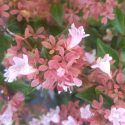
aka Red flowering Abelia
With its compact nature its almost non-stop flowering will look stunning in a pot or in the garden or even a hedge. Glossy green foliage is topped with masses of raspberry pink blooms that maintain their colour as they turn to seed heads. Easy care. Evergreen. PVR
The cooler months really bring out the colour of the seed heads.
PVR:
Habit: Compact
Leaves: Evergreen, Green
Mature Size 7-10 yrs (HxW): 100cm x 100cm
Abelia Raspberry Profusion
Current Stock Height: 20/25 cm ?
Container: 2.5l ?
$26.99
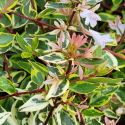
This easy to grow shrub has glossy, fresh green leaves with a creamy yellow edge. New spring growth is flushed red, creating interest early in the year. Tubular white flowers with a sweet smell are produced through the summer, much to the delight of bees. Perennial PVR
PVR:
Habit: Spreading
Leaves: Evergreen, Variegated
Abelia Sunshine Daydream
Current Stock Height: 10/20 cm ?
Container: 2.5l ?
$26.99
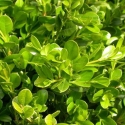
aka Box
A slow growing compact form of Box with a naturally rounded shape. In spring the fresh new growth is shaded a beautiful soft lime green turning to a darker glossy green on maturity. Easy to grow in sun or part shade. Evergreen.
'Green Gem' is the perfect choice for a low hedge as it doesn't need as much clipping as other Buxus due to its compact habit. Nice for topiary work too. Though 'Green Gem' is very tolerant and hardy it prefers not to have 'wet feet' in winter - quite understandable, I don't much like wet feet myself!
Leaves: Evergreen, Green
Mature Size 7-10 yrs (HxW): 60cm x 60cm
Buxus Green Gem
Current Stock Height: 10/15 cm ?
Container: 1l ?
$14.99
Buxus Green Gem
Current Stock Height: 15/25 cm ?
Container: 3.25l ?
$24.99
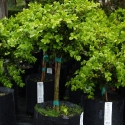
aka Box Std
This form of Buxus has attractive green leaves with lighter green new growth, suitable for classic small hedges and topiary work. Easy to grow in sun or part shade. Presented here as a standard. Evergreen.
Leaves: Evergreen, Green
Mature Size (HxW): Standard
Buxus Green Gem Std 70cm
Current Stock Height: STD-70/HGT-90 cm ?
Container: 10l ?
$99.99

aka Rock Rose
Rock Rose. A lovely little shrub for a sunny border or bank. The grey-green foliage is aromatic and has open faced blooms of pure white, with a crimson blotch and yellow centre making a very showy display in late spring. Prefers well drained soil, can tolerate drought once established. Evergreen.
Cistus should be trimmed lightly after flowering. They prefer a light soil and don't need a lot of feeding.
Habit: Compact
Leaves: Evergreen, Green
Mature Size 7-10 yrs (HxW): 75cm x 75cm
Cistus Lusitanicus
Current Stock Height: 15/20 cm ?
Container: 2.5l ?
$26.99
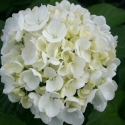
aka Mophead Hydrangea
Mophead. One of our favourite Hydrangeas. Gorgeous large white flower heads that open from soft lime green buds. Lovely to pick. Best planted in dappled light in soil that does not completely dry out in summer. Deciduous.
Information Pages
Habit: Compact
Leaves: Deciduous, Green
Mature Size 7-10 yrs (HxW): 1.2m x 1.2m
Hydrangea Bridal Bouquet
Current Stock Height: 20/30 cm ?
Container: 5l ?
$32.99
Hydrangea Bridal Bouquet
Current Stock Height: 30/40 cm ?
Container: 8l ?
$39.99
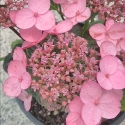
aka Cover Me series
Lacecap. Fill your garden with low lush foliage and stunning Hydrangea blooms all summer followed by stunning autumn foliage colours. Great for under planting and shady spots for colour and interest. Plant en masse for striking effect. Protect from hot, overhead, summer sun. Deciduous.
Information Pages
Habit: Bushy
Leaves: Deciduous, Green
Mature Size 7-10 yrs (HxW): 50cm x 100cm
Hydrangea Cover Me
Current Stock Height: 20/25 cm ?
Container: 3.5l ?
$32.99
Stock of this item is very low.
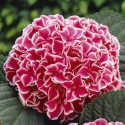
aka Mophead Hydrangea
Mophead Hydrangea. Tight rounded heads of bright pink petals edged with white set against dark green foliage make this easy to grow Hydrangea highly desirable. Has a dense bushy habit. Plant in morning sun or dappled shade in humus rich soil for best results. Deciduous.
Information Pages
PVR:
Habit: Compact
Leaves: Deciduous, Green
Mature Size 7-10 yrs (HxW): 1.5m x 1m
Hydrangea macrophylla Machiko
Current Stock Height: 30/40 cm ?
Container: 3.5l ?
$32.99

aka Lacecap Hydrangea
Lacecap. Gorgeous, large flattened flower-heads made up of a tight central zone of tiny flowers in tones of pink and blue surrounded by an outer halo of pink and white florets. Handsome green foliage completes the picture. Plant in morning sun or dappled light. Deciduous.
Information Pages
PVR:
Habit: Compact
Leaves: Deciduous, Green
Mature Size 7-10 yrs (HxW): 1.5m x 1m
Hydrangea Macrophylla Reiko
Current Stock Height: 30/40 cm ?
Container: 3.5l ?
$32.99
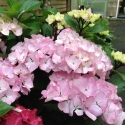
aka Mophead Hydrangea
Mophead. An enchanting soft pink mop head hydrangea with striking contrasting black stems, an outstanding specimen plant. Pink Maiden is free flowering with a profusion of flower heads on a neat and compact bush. Suitable for container growing, likes shade in the hottest part of the day. Deciduous.
Information Pages
Habit: Compact
Leaves: Deciduous, Green
Mature Size 7-10 yrs (HxW): 100cm x 100cm
Hydrangea Saxon Pink Maiden
Current Stock Height: 20/30 cm ?
Container: 4.5l ?
$36.99
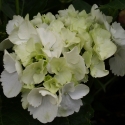
aka Mophead Hydrangea
Mophead. If you love the crispness of white flowers set against fresh green foliage then you will love this attractive Hydrangea. Big rounded heads of pure white flowers that appear from summer through to autumn. Nice compact habit so equally at home in a container or the garden. Prefers semi-shade.
Hydrangeas are relatively easy care shrubs but do best if they are planted in nice rich soil that does not completely dry out in summer.
Information Pages
Habit: Compact
Leaves: Deciduous, Green
Mature Size 7-10 yrs (HxW): 1.2m x 1.2m
Hydrangea Snowball
Current Stock Height: 20/30 cm ?
Container: 4.5l ?
$39.99
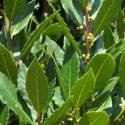
aka Bay Tree
A selected form of the ancient and ever popular Bay Tree. Having smaller leaves than other forms makes it ideal for topiary work. The leaves are aromatic, dark green and leathery and just love to be clipped or cooked! Tolerant of most conditions including coastal. Evergreen. Culinary.
Habit: Upright
Leaves: Evergreen, Green
Mature Size (HxW): Standard
Laurus Nobilis Tuscan Towers Std 120 cm
Current Stock Height: STD-120/HGT-160 cm ?
Container: 10l ?
$154.99
Stock of this item is very low.
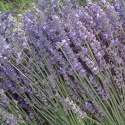
aka English Lavender
Lavandula. Bright violet blue flowers on long "pickable" stems and an intense perfume make this English Lavender one to add to your collection. Easy to grow in a warm well drained position. Trim after flowering to encourage strong healthy new growth. Suitable for drying and hedging. Evergreen. RHS AGM
Habit: Upright
Leaves: Evergreen, Green
Mature Size (HxW): 80cm x 80cm
Lavender Arabian Night
Current Stock Height: 10/20 cm ?
Container: 1.5l ?
$24.99

aka English Lavender
Lavandula. An 'English' type Lavender with deliciously aromatic foliage and flowers. The grey leaves are off set by dark purple flower heads that appear from summer through to early autumn. Makes a lovely hedge. Trims well (after flowering). Plant in a sunny well drained position. Evergreen
After trimming your Lavender dry the flower heads to use for potpourri. Top tip - put dried Lavender in the vacuum cleaner bag to perfume your whole home and keep the vacuum smelling sweet.
Habit: Upright
Leaves: Evergreen, Light
Mature Size (HxW): 60cm x 70cm
Lavender Foveaux Storm
Current Stock Height: 10/15 cm ?
Container: 1.5l ?
$24.99
Lavender Foveaux Storm
Expected Stock Height: 10/20 cm ?
New stock expected Middle of November, 2025. Waitlist now. Estimated price TBA. Payment on order.
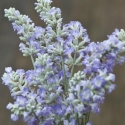
aka English Lavender
Lavandula. English Lavender. A highly fragrant Lavender with arching silver grey foliage and stems of dainty flowers that have a silver hue toned with soft violet. Very pretty when in full flower during summer. Plant in a warm well drained spot. Trim after flowering. Evergreen. PVR.
PVR:
Habit: Upright
Leaves: Evergreen, Light
Mature Size (HxW): 60cm x 90cm
Lavender Grace Leigh
Current Stock Height: 10/15 cm ?
Container: 1.5l ?
$24.99
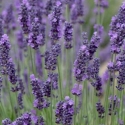
aka French Lavender
Lavandula Hybrid. A popular Lavender that produces an abundance of long stemmed, dark lavender flower heads through-out the summer. These are used commercially for dried flowers and oil production. Just lovely in the garden and will help attract bees. Well worth planting for the fragrance alone.
'Grosso' is probably one of the most deliciously fragrant of all the Lavenders available to gardeners' today. Evergreen.
Habit: Compact
Leaves: Evergreen, Light
Mature Size (HxW): 80cm x 80cm
Lavender Grosso
Container: 1.3l ?
$18.99
This plant will soon be in stock and can be pre-purchased now.
Lavender Grosso
Expected Stock Height: 5/10 cm ?
This plant is in high demand and supply is limited this year. Add to your Waitlist for updates on next available stock.
Lavender Grosso
Expected Stock Height: 15/25 cm ?
Currently sold out. Add to your waitlist to be advised when next in stock.
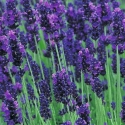
aka English Lavender
Lavandula. Named after one of England's finest gardens this lovely little English Lavender has intensely aromatic foliage and flowers. The deep purple flowers appear on fine stems in summer. Happiest in a sunny well drained position. Trim after flowering. Evergreen. RHS AGM.
Habit: Compact
Leaves: Evergreen, Light
Mature Size (HxW): 60cm x 60cm
Lavender Hidcote Blue
Current Stock Height: 15/20 cm ?
Container: 1.5l ?
$24.99
Lavender Hidcote Blue
Expected Stock Height: 25/30 cm ?
This plant is in high demand and supply is limited this year. Add to your Waitlist for updates on next available stock.
Lavender Hidcote Blue
Expected Stock Height: 10/15 cm ?
This plant is in high demand and supply is limited this year. Add to your Waitlist for updates on next available stock.
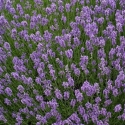
aka English Lavender
Lavandula. English Lavender. A dwarf, compact form with foliage and flowers that carry the true sweet lavender fragrance we all love. The fine, grey foliage is topped off with stalks of small flower heads in the peak of summer. Trim after flowering. Loves the sun and good drainage. Evergreen.
'Munstead' is named after Munstead Woods in Surrey - the home of renowned garden designer - the late Gertrude Jeckyl.
Habit: Compact
Leaves: Evergreen, Grey Green
Mature Size (HxW): 30cm x 30cm
Lavender Munstead
Current Stock Height: 10/15 cm ?
Container: 1.5l ?
$24.99
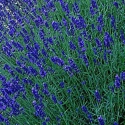
aka English Lavender
Lavandula. English Lavender. This selected form of the ever popular and very fragrant English Lavender will delight the senses with stems of intense blue-mauve flowers in the summer months. Aromatic fine grey foliage. Plant in a sunny well drained spot and trim after flowering. Evergreen.
Habit: Compact
Leaves: Evergreen, Light
Mature Size (HxW): 60cm x 45cm
Lavender Pacific Blue
Current Stock Height: 11/15 cm ?
Container: 1.5l ?
$24.99
Lavender Pacific Blue
Expected Stock Height: 10/15 cm ?
We are awaiting confirmation from our supplier for an expected delivery date. Express your interest by adding to your Waitlist.
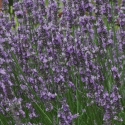
aka French-English Hybrid Lavender
Lavandula. This is a stunning hybrid lavender which is both tall and sturdy. With large aromatic grey foliage and long stems of intensely aromatic purple flower heads it is a very desirable plant. Plant in a sunny well drained position. Evergreen.
Lavender 'Super' can be grown as a hedge or used in the border for colour and fragrance. Lavender flowers are great for attracting bees to the garden so they ideal to plant near the vegetable garden to assist with pollination.
Habit: Upright
Leaves: Evergreen, Light
Mature Size (HxW): 80cm x 60cm
Lavender Super
Current Stock Height: 20/30 cm ?
Container: 2.5l ?
$26.99
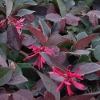
aka Fringe Flower
An attractive and easy care shrub with arching branches of deep burgundy wine foliage. In spring and summer dark pink 'fringed' flowers appear and these carry a pleasant fragrance. Easy to grow in sun or part shade, prefers well drained soil. Provides a nice contrast to green. Evergreen.
AKA 'The Fringe Flower' Loropetalum is in the same family as 'Witch Hazel'. It has quite a broad habit but responds well to trimming if you wish the shrub to have a more rounded shape.
Habit: Arching
Leaves: Evergreen, Red
Mature Size 7-10 yrs (HxW): 2m x 2.5m
Loropetalum Burgundy
Current Stock Height: 10/15 cm ?
Container: 2.5l ?
$26.99
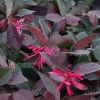
aka Fringe Flower
An attractive and easy care shrub with arching branches of deep burgundy wine foliage. In spring and summer dark pink 'fringed' flowers appear and these carry a pleasant fragrance. Easy to grow in sun or part shade, prefers well drained soil. Presented here as a topiary standard.
Habit: Arching
Leaves: Evergreen, Red
Mature Size (HxW): Standard
Loropetalum Burgundy Std
Current Stock Height: STD-60/HGT-100 cm ?
Container: 10l ?
$144.99
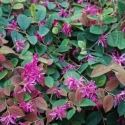
aka Fringe Flower
An interesting shrub with neat oval leaves that are shaded in tones of burgundy and deep green. The shaggy bright pink 'fringed' flower heads appear in spring. The growth habit is slightly lax and pendulous. Easy to grow in sun or part shade. Prefers a slightly acid soil. Evergreen.
Habit: Arching
Leaves: Evergreen, Green
Mature Size (HxW): Standard
Loropetalum China Pink Std 70cm
Current Stock Height: STD-70cm/HGT-90cm ?
Container: 10l ?
$99.99
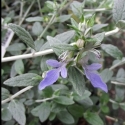
aka Germander
This evergreen shrub from the Mediterranean loves hot dry spots and does well at the sea-side. Attractive tubular blue flowers are set amoungst aromatic silver grey leaves from spring to summer. Makes a fantastic low hedge and clips well. Happiest in light well drained soil.
The secret to your Teucrium hedge looking good is regular trimming however it is important that your last trim for the summer is done no later than mid March.
Habit: Arching
Leaves: Evergreen, Light
Mature Size 7-10 yrs (HxW): 1.5m x 1.5m
Teucrium Fruticans
Current Stock Height: 40/60 cm ?
Container: 3.3l ?
$29.99
HL Nurseries Limited t/a Wairere Nursery
826 Gordonton Road, R D 1, Hamilton 3281 Ph: (07) 824 3430 Email: